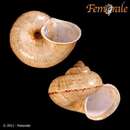en
names in breadcrumbs


Die Cyclophoridae, auch als Turmdeckelschnecken bezeichnet,[Anmerkung 1] sind eine Familie auf dem Land lebender Schnecken aus der Ordnung der Architaenioglossa (Caenogastropoda). Die Familie wird heute in einem eingeschränkten Umfang aufgefasst; die Vertreter der Familie sind auf die Tropen und Subtropen der Alten und Neuen Welt beschränkt.
Die rechtsgewundenen Gehäuse sind meist klein und werden eher selten mittelgroß. Die Gehäuseform variiert von scheibenförmig bis hochkonisch. Die meist rundliche Mündung ist vielfach modifiziert, zuweilen auch mit einem Einschnitt oder einer Einschnürung; die letzte Windung kann stark aus der Windungsebene abfallen. Es ist ein meist kreisförmiges Operculum vorhanden, das tief in das Gehäuse zurückgezogen werden kann. Es ist eng spiralig gewickelt und kann verkalkt oder unverkalkt sein. Auf der Außenseite des Operkulums können akzessorische Auflagerungen vorhanden sein.
Der Kopf endet in einem kurzen Rüssel oder Schnauze. Die Fühler sind im Querschnitt rund, verhältnismäßig lang und verjüngen sich zum Ende hin etwas. Die Augen sitzen an der Basis der Fühler auf flachen Papillen. Die Kriechsohle ist längs nicht unterteilt. Die Mantelhöhle fungiert als Lungenhöhle. Die Radula weist sieben Elemente pro Querreihe auf. Die Mittelplatte besitzt in der Regel fünf, seltener auch drei oder sieben Zähne. Die Tiere sind getrenntgeschlechtlich.
Die Familie ist sehr artenreich, die Arten kommen fast weltweit in warmen Klimabereichen vor.
Bisher gibt es keine umfassende Revision der Familie. Der Bearbeitungsstand vieler Gattungen ist denkbar schlecht. Die Liste der Unterfamilien und Gattungen ist daher unsicher.
Die Cyclophoridae, auch als Turmdeckelschnecken bezeichnet, sind eine Familie auf dem Land lebender Schnecken aus der Ordnung der Architaenioglossa (Caenogastropoda). Die Familie wird heute in einem eingeschränkten Umfang aufgefasst; die Vertreter der Familie sind auf die Tropen und Subtropen der Alten und Neuen Welt beschränkt.
Cyclophoridae is a taxonomic family of small to large tropical land snails with an operculum, terrestrial gastropod mollusks in the order Architaenioglossa belonging to the subclass Caenogastropoda (according to the taxonomy of the Gastropoda by Bouchet & Rocroi, 2005).
This diverse family with many species is now limited to the representatives in the tropics and subtropics of the Old and New World.
Their fossil history dates back through the Early Tertiary[1] to the Cenomanian age of the Cretaceous.[2]
The dextral shells are mostly of small and rarely medium size. The form of the shell varies from discoidal to turbinate. The round aperture is often modified, sometimes with an incision or a constriction. The last whorl can sometimes be disconnected and then extends strongly from the winding plane. The operculum is generally circular, which can be retracted deeply into the shell. Its form is multispiral and can be calcified or lacking calcareous overlay. The outer layer of the operculum can contain accessory deposits.
The head of the soft body ends in a short proboscis. The tentacles are round in cross-section, relatively long and taper to the end. The eyes are located at the base of the antenna on flat papillae. The longitudinal muscular foot is not divided. The mantle cavity acts as a lung cavity. The taenioglossan radula has seven elements per transverse row. The central row of the radula contains usually five, rarely three or seven teeth. The animals are dioecious.
This family consists of the following subfamilies according to the taxonomy of the Gastropoda by Bouchet & Rocroi, 2005, which adapted the tribes of Cyclophorinae from the system used by Wenz (1938).[3] Thirty five genera containing approximately 810 species have been recognized as in 2008.[4]
Some notable genera are also listed here:
Cyclophoridae is a taxonomic family of small to large tropical land snails with an operculum, terrestrial gastropod mollusks in the order Architaenioglossa belonging to the subclass Caenogastropoda (according to the taxonomy of the Gastropoda by Bouchet & Rocroi, 2005).
This diverse family with many species is now limited to the representatives in the tropics and subtropics of the Old and New World.
Their fossil history dates back through the Early Tertiary to the Cenomanian age of the Cretaceous.
Les Cyclophoridae sont une famille de mollusques gastéropodes terrestres de la super-famille des Cyclophoroidea.
Alycaeinae - Cyclophorinae - Pterocyclinae - Spirostomatinae
Anosycolus – Dominamaria – Nobuea – †Palaeocyclophorus – †Tropidogyra – Ventriculus
Les Cyclophoridae sont une famille de mollusques gastéropodes terrestres de la super-famille des Cyclophoroidea.
Cyclophoridae is een familie van weekdieren uit de klasse van de Gastropoda (slakken).
Cyclophoridae is een familie van weekdieren uit de klasse van de Gastropoda (slakken).
環口螺科(學名:Cyclophoridae),又名山蝸牛科、旋風蝸牛科[1]或叢螺科[2],是一個小型到大型的熱帶陸地蝸牛的系統分類科,而且牠們都有口蓋(英语:operculum (gastropod))。根據2005年的《布歇特和洛克羅伊的腹足類分類》,牠們都屬於新進腹足類主扭舌類非正式群組的陸地(英语:Terrestrial molluscs)腹足綱軟體動物;在2017年的《布歇特等人的腹足類分類》,牠們的分類層級不變。
這個包含很多物種的高度多樣性分類單元,現時只包括舊世界和新世界熱帶及亞熱帶的物種。
本科的化石物種歷史最早可以追遡至古近纪,正常腹足綱物種爆發時期[3]。
The dextral shells are mostly of small and rarely medium size. The form of the shell varies from discoidal to turbinate. 其圓形的aperture一般都有修飾:有時會有一個裂口,又或 a constriction. 其最後的whorl(英语:Whorl (mollusc)) can sometimes be disconnected and then extends strongly from the winding plane. The operculum(英语:Operculum (gastropod)) is generally circular, which can be retracted deeply into the shell. Its form is multispiral and can be calcified or lacking calcareous overlay. The outer layer of the operculum can contain accessory deposits.
軟體的頭部有一個短短的吻部(英语:proboscis)。 The tentacles are round in cross-section, relatively long and taper to the end. The eyes are located at the base of the antenna on flat papillae. The longitudinal muscular foot is not divided. The mantle cavity acts as a lung cavity.其扭舌型齒舌每列都有七顆舌齒: has seven elements per transverse row. The central row of the radula contains usually five, rarely three or seven teeth.The animals are 雌雄異體.
2005年的《布歇特和洛克羅伊的腹足類分類》採納了Wenz (1938)對當時還是「山蝸牛亞科」的分類方法,將這個亞科分為多個族[4]。 這個分類將35個屬810個物種分配到下列各個亞科中[5]。部分列出如下:
李彥錚2003的参考文献提供内容
環口螺科(學名:Cyclophoridae),又名山蝸牛科、旋風蝸牛科或叢螺科,是一個小型到大型的熱帶陸地蝸牛的系統分類科,而且牠們都有口蓋(英语:operculum (gastropod))。根據2005年的《布歇特和洛克羅伊的腹足類分類》,牠們都屬於新進腹足類主扭舌類非正式群組的陸地(英语:Terrestrial molluscs)腹足綱軟體動物;在2017年的《布歇特等人的腹足類分類》,牠們的分類層級不變。
這個包含很多物種的高度多樣性分類單元,現時只包括舊世界和新世界熱帶及亞熱帶的物種。
本科的化石物種歷史最早可以追遡至古近纪,正常腹足綱物種爆發時期。